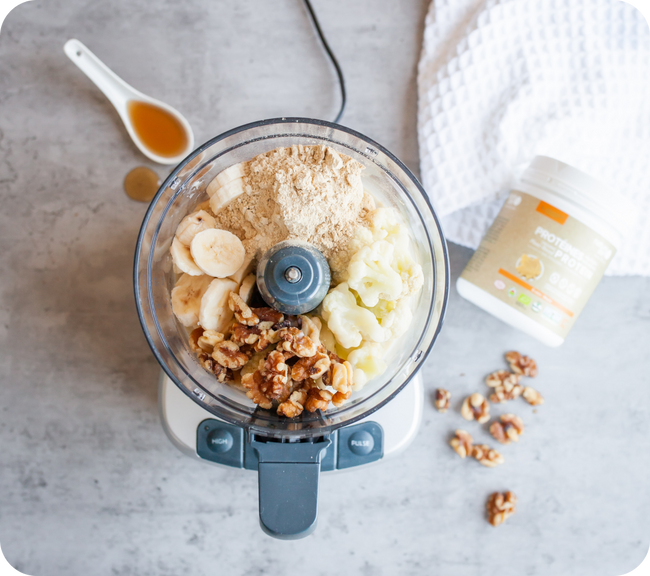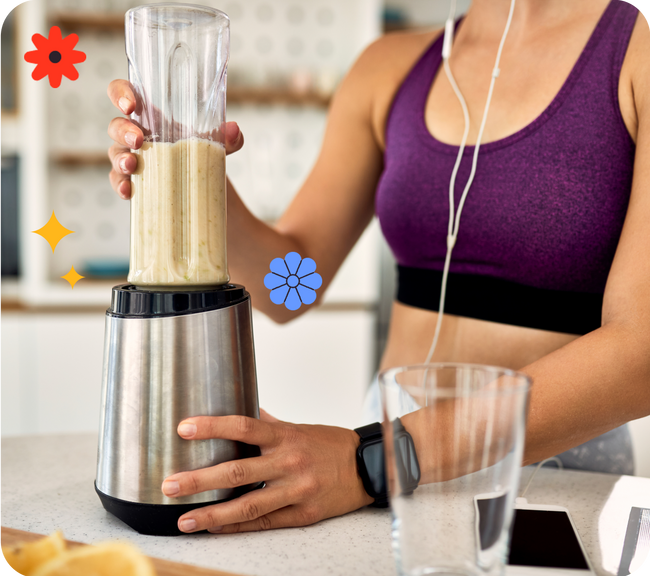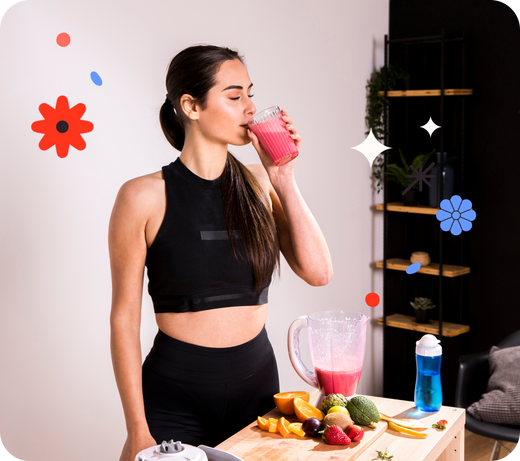Protein shakes are delicious drinks that help you build muscle and lose weight faster. You can also use protein shakes for weight gain if that’s your target. Even if you are diabetic, there is no reason to avoid protein drinks.
Protein shakes are, in fact, beneficial for diabetics, provided you follow certain simple and easy rules. With the right combination of ingredients, protein shakes can help diabetics meet many of their nutritional needs while keeping their blood sugar levels stable.
So here’s everything you need to know about protein shakes for diabetics: Stay tuned for the best tips and the most delicious protein shake recipes for diabetics. Let’s dive in!
Key Takeaways:
- Diabetics can drink protein shakes safely as long as they are made using the right ingredients and consumed in moderation.
- You must choose your protein sources wisely, paying extra attention to their carb and added sugar content.
- To customize your protein shakes for weight gain, increase the total calories of the drink by adding more fat content, not sugar or carbs.
Can diabetics drink protein shakes?
Yes, diabetics can drink protein shakes. However, it's important to choose the right ingredients to manage blood sugar levels effectively. You also need to monitor your portion sizes. Make sure to choose protein powders that are low in carbs and added sugars.
When making protein smoothies, you can add diabetic-friendly ingredients such as leafy greens, non-starchy vegetables, and low-sugar fruits. You can modify its consistency by adding water, milk, or plant-based milk derived from almonds or soy.
You can even turn them into a meal replacement shake by adding the right ingredients. Try adding some instant coffee powder to your protein shake and making a protein coffee. You can have this protein coffee for breakfast to kickstart your day with energy.
However, don't depend solely on protein shakes for nutrition. It is not advisable to use protein shakes to replace more than one main meal in a day.
Steps to make a diabetic-friendly protein shake:
You can quickly whip up a diabetic-friendly, delicious, and nutritious protein shake in just a few simple steps:
-
Select your protein source:
This serves as the base for your shake. You can opt for natural, wholesome ingredients such as Greek yogurt, soy or almond milk, silken tofu, any nut butter, chia or hemp seeds, etc.You can focus on just one protein source, such as peanut butter or Greek yogurt, to create a specific flavor of protein drink. You can also combine different protein sources to increase the protein content and flavor.
The easiest way to ensure you get all the essential amino acids is to use a high-quality protein powder. Unsweetened versions are also available. Even if it says no added sugar or is diabetic-friendly, make it a point to read the label and check for artificial sweeteners as well.
-
Add low-sugar fruits or veggies
The key to customizing a protein shake for diabetics is to increase its fiber content. Fiber slows down the absorption of glucose and prevents spiking your insulin levels.Fruits and vegetables are highly nutritious, as they offer you fiber, vitamins, minerals, and antioxidants. You can also enhance the flavor of your protein shake by adding low-sugar fruits, such as berries.
You can experiment with many berry varieties, including strawberries, blueberries, and raspberries, since they have a high fiber content and a low glycemic index. It's better to avoid high-carb ingredients such as bananas and mangoes, although you can still enjoy these in moderation.
Adding leafy vegetables such as spinach, arugula, or kale can ramp up your nutritional intake without much impact on your blood sugar levels.
-
Use unsweetened dairy or plant-based milk
Once you add your protein sources, fruits, and vegetables to the blender, it's time to add some fluid. You can skip these elaborate steps and simply mix some protein powder with water and drink. However, following these steps will offer you a more delicious and nutritious drink.The texture and thickness of your protein shake depend on what and how much fluid you use. Cow's milk is the most commonly used. This offers a creamy texture and even more protein and minerals. Other suitable choices include almond milk, coconut milk, soy milk, and oat milk. If you are diabetic, you need to make sure to get the unsweetened versions of the milk you choose.
-
Sweetening your drink
The question here is whether to sweeten it or not. Is it alright to add a little sugar? What about sugar alternatives, such as monk fruit or stevia? How about honey, jaggery, or maple syrup?It's best if you can stick to low-carb fruits to sweeten your drink rather than add extra sugar. However, the choice is really up to you.
It's preferable to add some honey or even a small spoonful of sugar rather than harmful artificial sweeteners such as aspartame or sucralose. The latter can disrupt your gut microbiota.
To enhance its taste without increasing its sugar content, you can opt for natural flavorings such as vanilla extract, cinnamon, or unsweetened cocoa powder. You should experiment with different ingredient combinations to find what suits your preferences and dietary needs.
Dos and Don’ts of Protein Shakes for Diabetics:
Now let's quickly sum up some of the dos and don’ts of making diabetic-friendly protein shakes:
- Choose unsweetened protein powders.
- Prioritize whole foods such as yogurt, plant-based milks, and chia seeds when choosing a protein source.
- Include fiber-rich foods like vegetables or chia seeds in your diet.
- Don't add extra sugar or sweetened ingredients.
- Use low-glycemic fruits, such as berries, to naturally sweeten your drink.
- Don't rely solely on protein shakes for nutrition. Have balanced meals.
- Avoid using harmful artificial sweeteners, such as aspartame.
5 protein shakes for diabetics that are easy to make
Here are five delicious protein shake recipes for diabetics. You can adjust the ingredients and portion sizes as needed.
-
Chocolate Peanut Butter Delight:
In a blender, add 1 scoop of chocolate protein powder, 1 tablespoon of natural peanut butter, 1 small banana, and ¾ cup of unsweetened milk. Blend until smooth, and serve topped with dark chocolate curls. -
Blueberry Blast:
Blend a scoop of vanilla protein powder, ½ cup of mixed blueberries, a cup of unsweetened almond milk, and a tablespoon of chia seeds. You can adjust the consistency by adding more almond milk. You can try this drink before bed as a dinner replacement if you have eaten balanced meals earlier in the day and feel like having something lighter. -
Creamy Coffee Shake:
Make a protein shake by blending a scoop of unflavored protein powder, 1 tablespoon of unsweetened cocoa powder, ½ cup of brewed coffee, ½ cup of unsweetened almond milk, and some ice cubes. You can sweeten this with erythritol or monk fruit. This coffee protein shake recipe is ideal for making a breakfast smoothie. -
Tropical Pineapple Shake:
Blend a scoop of vanilla protein powder, ½ cup of frozen pineapple chunks, and ¾ cup of unsweetened coconut milk. Serve topped with a sprinkling of shredded coconuts. You can substitute the pineapple with frozen mango pieces. When using fruits, remember to practice portion control. You can still enjoy them in small quantities. -
Green Super Shake:
Add a cup of spinach, half an avocado, ½ cucumber, 1 tablespoon of almond butter, and a cup of unsweetened coconut milk to your protein shake to turn it into a super green smoothie. Blend until smooth before adding the protein powder. You can use a scoop or more of unflavored or vanilla protein powder.
How much protein is recommended for diabetics?
According to the American Diabetes Association (ADA), diabetics should aim for a balanced diet with 15-20% of their total daily calories coming from protein.
This is only a general recommendation. You should keep in mind that individual protein needs can vary according to physical activity levels, fitness goals, and underlying medical conditions.
The best protein sources for diabetics
For diabetics, the best protein sources include:
- Eggs are a nutrient-dense protein source.
- Lean meats, such as chicken and turkey.
- Fatty fish and seafood rich in omega-3.
- Plant-based options such as legumes, tofu, and tempeh.
The worst protein sources to avoid
Although these foods contain a good amount of protein, they are not considered healthy sources since they tend to be high in added sugars, sodium, and other unhealthy additives. This includes:
- Sugary protein bars and drinks.
- Processed meats high in sodium and additives.
- Deep-fried or breaded protein sources.
- Meat marinated in sauces with added sugars.
The best sweeteners for diabetics:
You can calculate your daily sugar intake using online sugar calculators and find out how much you take in a day. Sweeteners do not spike insulin levels the way refined sugar or honey does. Some sweeteners, such as aspartame, are known to disturb your gut microbiome.
Diabetics can choose from:
- Natural sweeteners such as stevia or monk fruit
- Artificial sweeteners, such as sucralose
- Sugar alcohols, such as erythritol
Conclusion


Protein shakes can be a valuable addition to a diabetic's diet, provided you pay extra attention to the ingredients used for making the drink. The base should be a high-quality, unsweetened protein source.
Adding low-sugar fruits, non-starchy vegetables, and other low-carb ingredients increases the fiber content, making the drink more nourishing and helping manage your blood sugar levels effectively.
Frequently Asked Questions

F.A.Q

How to make protein shakes for diabetics to gain weight?
To gain weight, you need to increase your calorie intake. Instead of focusing on sugar or carbs, concentrate on adding calories from fat.
To make a calorie-rich, low-sugar protein shake, add ingredients such as seeds, nuts, nut butter, avocados, and full-fat dairy. You can also add fresh cream, coconut oil, MCT oil, etc. to ramp up the fat and calorie content.
How to make protein shakes for diabetics to lose weight?
Protein shakes are great for weight loss as long as you keep the total calories and sugar content under check. To make this, you should use ingredients such as unsweetened protein powder, low-fat yogurt, non-starchy vegetables, and low-sugar fruits like berries.
Do protein shakes spike blood sugar?
Depending on the ingredients used in your protein shake, it can spike your blood sugar. To minimize this impact, customize your drink with low-sugar alternatives.
Is peanut butter good for diabetics?
Yes, peanut butter is good for diabetics. They can be added to protein shakes. Make sure to check the product label and buy one that’s free of added sugar.
Is a protein shake good for diabetes?
Yes, protein shakes are good for diabetics. When consumed in moderation, protein helps stabilize your blood sugar levels.
In comparison to carbs, protein does not have much impact on insulin levels. Protein increases satiety, keeps you feeling full longer, and helps overcome food cravings.
Can a diabetic replace a meal with a protein shake?
Yes, diabetics can replace a meal with a protein shake, as long as the shake contains the right combination of ingredients to provide a nourishing meal in itself.
However, if you are on medications, it's best to consult with your healthcare provider before replacing meals with protein shakes.


































